


Zinc plating of copper coin
This experiment is really remarkable. It shows how a copper object can be plated with a beautiful shiny zinc layer from a strongly alkaline solution, containing zincate ion.
This reaction is an electrochemical reaction, in which a copper object acts like an electrode, on which zinc is deposited. This reaction is reversible and depends on whether the copper object is touched by a piece of zinc or not.
![]()
![]() Required
chemicals:
Required
chemicals:
-
zinc, small pieces or a strip. Any form, but fine powder is suitable
- zinc oxide or any zinc salt
- sodium hydroxide
- vinegar or very dilute nitric acid for cleaning a coin
![]() Required
equipment:
Required
equipment:
-
glass beaker
-
a means of heating the contents of the beaker
![]() Safety:
Safety:
- Sodium hydroxide and its solutions are very caustic, especially the hot solution. Be very careful not to get this on your skin. This solution is really bad for the eyes. A splash of the concentrated solution in an eye will almost instantly lead to blindness!
![]() Disposal:
Disposal:
- The waste can be flushed down the drain. Solid pieces of zinc remaining can be thrown away as standard household waste. The amount of zinc used in this experiment only is small.
![]()
Preparation of a solution of sodium zincate
Dissolve approximately 2 grams of sodium hydroxide in approximately 10 ml of water and add a spatula full of zinc oxide. A white suspension is obtained, which, however, becomes clear again after a while. The liquid becomes quite hot due to hydration of the sodium hydroxide. The zinc oxide dissolves. If a soluble zinc salt is used, then first a white precipitate is formed, which redissolves again in the fairly concentrated solution of sodium hydroxide.
After this step, a colorless and clear solution should be obtained. If the solution is not totally clear, then add a small amount of sodium hydroxide and a little amount of distilled water as well.
Preparing a copper coin for this experiment
Take a copper coin, which is not dirty or strongly oxidized. Preferably a new unused coin is taken, but if a used one is taken, then it can be cleaned easily by immersing it in vinegar or very dilute nitric acid (at most 5% by weight). Do not immerse the coin in more concentrated acids, because that may cause damage to the coin as well (especially for the nitric acid). Also do not use dilute hydrochloric acid, this does some harm to the surface of the metal.
If nitric acid is used, then the coin will be nice and shiny within a few seconds. If vinegar is used, then that may take several minutes. If the coin is nice and shiny, then take it out of the acid with a pair of tweezers, rinse it with water and put it in the alkaline solution of sodium zincate.
Plating the coin with a thin zinc layer
Heat the solution, with the coin in it. The liquid does not need to be boiled, but making it quite hot makes the reactions go much faster.
Nothing happens to the coin when it is left in the solution. Things totally change, when some pieces of zinc are put in the liquid and when these are allowed to touch the coin. As soon as a piece of zinc touches the coin, it becomes plated with a layer of zinc. In the hot solution, this plating is quite fast. Within a few tens of seconds, the coin is completely covered by a shiny zinc layer. The picture below shows the coin, under approximately 1 cm of solution, with some small granules of zinc in the beaker. On top of the coin (and also under the coin) are some granules of zinc. The picture nicely shows that the coin is completely covered with zinc. For comparison another similar coin is placed besides the beaker.
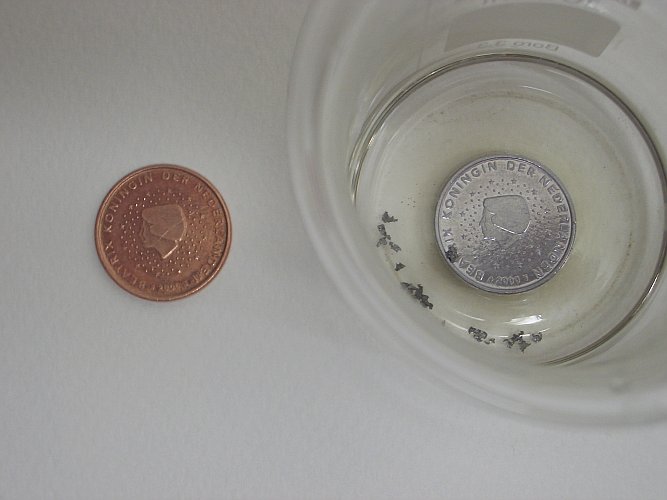
As soon as the coin is maneuvered through the liquid, such that it does not touch any small piece of zinc, then the zinc plating slowly disappears again. In a few tens of seconds, the coin becomes red/yellow again. This can be explained, because zinc slowly dissolves in alkaline liquids, giving hydrogen gas and zincate ion.
Taking the coin out of the liquid
When the coin is taken out of the liquid with a pair of tweezers, then it quickly turns yellow and stained, because of partial and irregular dissolving of the thin zinc layer in drops of alkaline liquid, which adhere to the coin. So, this is not a suitable way to take it out of the liquid.
In order to obtain a silvery coin with a grayish/bluish hue, the liquid and coin must be dumped at once in a large volume of water. Take a bucket and fill this with a few liters of cold tap water and at once dump the contents of the beaker in this bucket of water and swirl this carefully for a few seconds in order to dilute the alkaline liquid very quickly. This assures that the zinc on the coin has no time to dissolve in the alkaline solution again.
The water in the bucket will turn somewhat turbid, due to hydrolysis of the zincate, in which zinc hydroxide is formed.
Quickly decant the water in the bucket and assure that the coin and remaining small pieces of zinc are not flushed accidentally down the drain. Quickly take the coin out of the bucket with a pair of tweezers and rinse it well under a running tap and then put it on a paper tissue. Do not touch the coin with your fingers. Carefully wipe off any water from the coin with the paper tissue. The result is really stunning!
Below, some pictures of the coin are shown, together with another similar coin, which was made very clean and shiny as well. The next two pictures show the pair of coins, with positions exchanged. In this way, both coins are shown in both lighting and reflecting conditions and that allows good comparison.
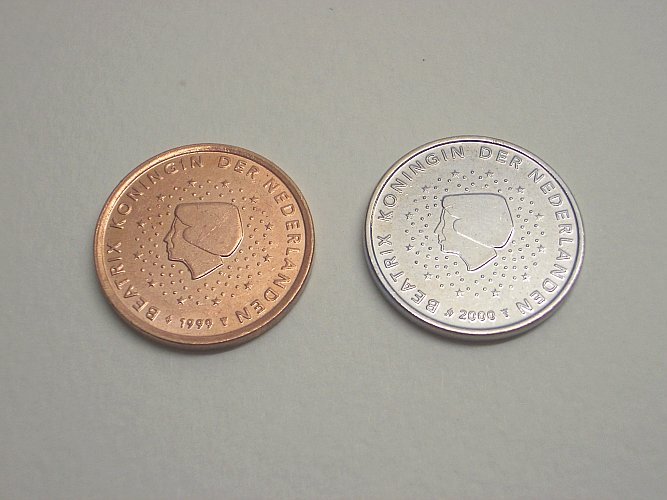
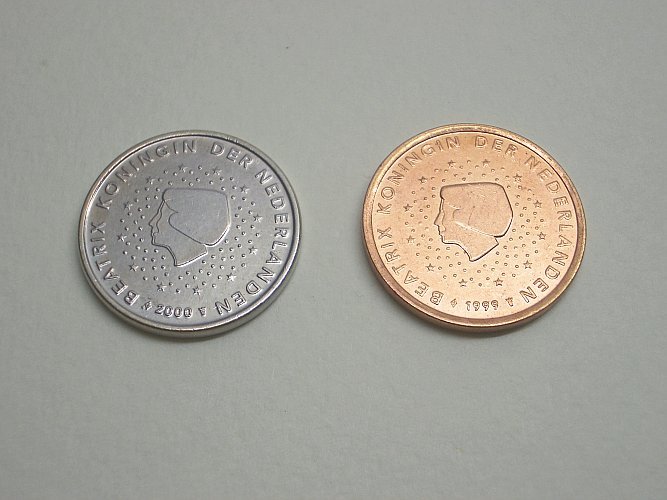
The picture below shows the same pair of coins, but now the other side. Here, one can see that the plating of the zinc is a little less perfect. This is because this side was below and the coin was moved on top some of the zinc granules. But still, the coin looks quite neat, also on this side.
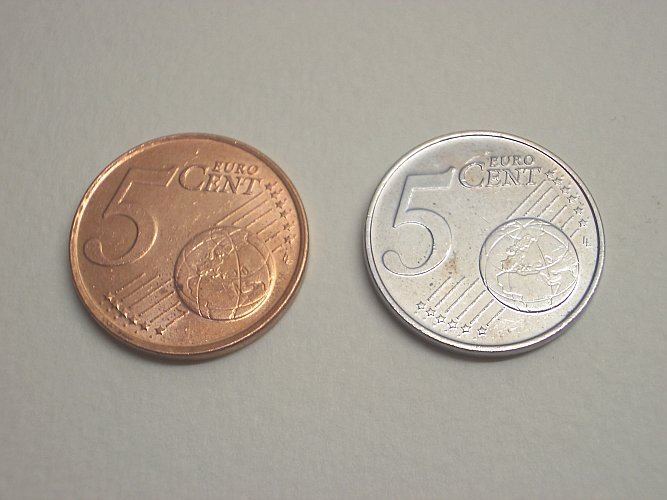
Such a zinc-plated coin is very vulnerable. The layer of zinc is very thin (probably less than a μm) and when it is exposed to grease from one's hand, then it quickly corrodes and becomes stained. So, if the coin has to remain as nice as this, then it should be stored in an air-tight place, wrapped in a soft piece of paper tissue.
![]()
Two years later...
The silvery coin was stored in an airtight wrapper, in soft tissue. Two years after putting it in this wrapper, the coin has become gold-like! The following picture shows the coin, together with a new 5 cents coin.
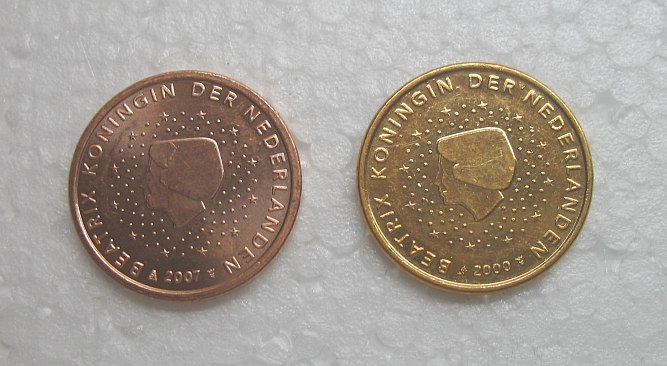
![]()
Discussion of the results
Zinc oxide and zinc hydroxide dissolve in strongly alkaline solutions, giving the zincate ion. Zinc is an amphoteric metal in its +2 oxidation state.
ZnO(s) + 2OH–(aq) → ZnO22-(aq) + H2O(l)
Zn(OH)2(s) + 2OH–(aq) → ZnO22-(aq) + 2H2O(l)
Metallic zinc also dissolves in strongly alkaline solution, especially when the solution is hot:
Zn(s) + 2OH–(aq) → ZnO22-(aq) + H2(g)
The latter reaction is responsible for quick destruction of the zinc layer, when the zinc-plated coin is left in the liquid without contact with a piece of zinc. The amount of hydrogen, formed from the ultra-thin layer of zinc is so small, that it only can be observed, when watched very carefully.
When a copper coin is in contact with a piece of zinc, then an electrolytic cell is produced and a current flows. Electrons flow from the piece of zinc to the copper coin. At the surface of the copper coin, these electrons reduce the zinc, present in solution:
ZnO22-(aq) + 2H2O(l) + 2e → Zn(s) + 4OH–(aq)
At the surface of the piece of zinc, the electrons, which are flowing to the copper metal, are compensated for by producing zinc (II) ions as zincate:
Zn(s) + 4OH–(aq) → ZnO22-(aq) + 2H2O(l) + 2e(flowing to copper)
The net reaction is null, but effectively there is moving of zinc. Zinc, dissolving at the little pieces, is plated on the copper.
This phenomenon is well known. A more electropositive metal, when brought in contact with a less electropositive metal tends to produce a current. When the liquid in which both metals are immersed, is conductive, then a redox reaction is started, with the more electropositive metal going in solution and the less electropositive metal surface acting as a reductor (giving electrons). This effect also is deployed commercially for protection of surfaces of ships, railways and other metal objects. A sacrificing anode of a more electropositive metal (zinc or magnesium) is connected to the object to be protected against corrosion.
This process of zinc-plating continues, until the copper coin is fully covered with zinc. From that point, an equilibrium is achieved, with the plating reaction and the reaction, in which zinc dissolves in alkaline solution competing.
Two years later...
The golden color of the coin, after two years of storage, most likely is due to diffusion of zinc atoms into the upper copper layer. This golden color can be obtained in minutes, when the coin is heated, immediately after drying it. But that it also is obtained after two years of storage is quite remarkable. Apparently, metals are not as solid and fixed as they are always thought to be.